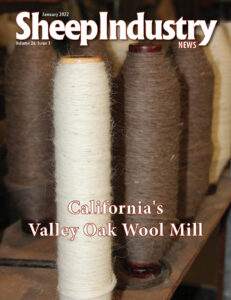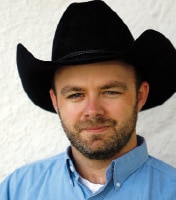JULIE STEPANEK SHIFLETT, PH.D.
Juniper Economic Consulting
The million-dollar question facing this industry in 2022 is whether the current hot market is sustainable. Last year, slaughter lamb prices climbed 48 percent, and the wholesale market climbed 50 percent to record-breaking levels.
The last couple of years revealed an undeniable increase in lamb demand in the United States. COVID-prompted demand coupled with relatively tight domestic supplies supported prices at new highs and attracted imports. Even if the domestic supply situation eases into 2022, it is possible that strong demand will continue to prop up prices well into 2022.
Higher live and meat prices can encourage flock expansion, continued investments in sheep infrastructure including packing houses, markets, and research and development. However, higher lamb prices are only one-half of the flock expansion equation. There are continued constraints to expansion including higher labor and feed costs and ongoing predator losses that muddle forecasting efforts. With the West embroiled in a record drought, pasture and forage costs will continue to rise, and most feed concentrate prices are higher (soybeans might be the exception).
Forecasts
The Livestock Marketing Information Center forecasted in early December that production could stabilize in 2022, however, the combination of lower beginning stocks and a projected 4 percent decline in imports in 2022 could mean a 3 percent drop in both lamb availability and per capita consumption.
In early December, LMIC forecasted that in 2022 national direct slaughter lambs could see $213 to $228 per cwt., up 0.5 percent annually. The three-market average for 60 to 90 lb. feeders could see $256 to $271 per cwt, down about 1 percent from 2021.
A December report by the U.S. Department of Agriculture’s Economic Research Service arrived at a similar conclusion. It suggests that meat prices could stay high in 2022, but tempered. Meat prices overall were expected to increase 5 to 6 percent in 2021 year-on-year and are projected to rise another 2 to 3 percent in 2022. Prices in the “Other Meat” category (notably lamb) are forecasted to see a 1 to 2 percent increase in 2022.
The price spread between wholesale lamb prices and slaughter lamb prices received by lamb producers has increased through the pandemic. The widening share might be explained by increased processing costs, including labor shortages and supply chain disruptions. The widening spread might also be explained by an increasing share of value-added lamb products at retail, such as pre-seasoned roasts.
Feeder and Slaughter Lamb Prices Stronger
Sixty to 90 lb. feeder lamb prices at auction averaged $292.40 per cwt. in November, up 11 percent monthly and up 37 percent year-on-year. Prices at San Angelo, Texas, and Fort Collins, Colo., averaged $293.00 per cwt. and $273.67 per cwt., respectively, while prices topped $3 per lb. in Sioux Falls, S.D., at $310.53 per cwt.
In November, the slaughter lamb market remained well above $2 per lb. At auction, Choice and Prime 1 to 2, 100 to 150 lb. lambs averaged $272.00 per cwt., up 10 percent monthly and up 28 percent from 2020. Prices at Fort Collins and Sioux Falls both saw $227 per cwt. in November, about 43 percent higher than last year.
Hair lamb prices at the New Holland, Penn., auction saw a high of $303.46 per cwt. for 50 to 60 lb. lambs, which was up 15 percent monthly and 19 percent higher year-on-year (Good and Choice 1 2). Prices per cwt. fell for heavier weight classes with the 90 to 100 lbs. class averaging $217.42 per cwt., up 23 percent monthly and up 28 percent year-on-year.
Live, negotiated slaughter lamb market prices saw a 4 percent softening in November with prices easing to $231.22 per cwt. while still boasting a 38 percent premium compared to last year. Live weights in the live, negotiated trade averaged 143 lbs. in November, 7 percent heavier year-on-year from 134 lbs., suggesting that the supply situation has eased.
Domestic Production Down; Imports Up
In January to November, estimated lamb harvest rose 1 percent year-on-year to 1.6 million head while estimated lamb production dropped 2 percent to 75.5 million lbs., due to lower harvest weights.
Live weights in federally inspected harvest fell from 129 lbs. to an estimated 126 lbs. in 2021, down 2 percent. In the last 20 years, live weights at harvest have fallen from an average of 140 lbs. to under 130 lbs. by 2020. The lower average can be explained by the assimilation of lighter-weight hair lambs and wooled breeds into federally inspected harvest.
Lamb and mutton in cold storage fell by about 50 percent from mid-2020 to November 2021. In 2021, from January to December, inventories bounced around from about 21,000 to 27,000 lbs.
At 141,729 head, the Colorado feedlot inventory was 111 percent of 2020’s December inventory, and 97 percent of the five-year average for the month. While lamb supplies were tight for wooled lambs during the summer, the fall saw a surge in feedlot placements, to levels not seen for about four years.
According to the Meat & Livestock Australia Sheep October Update, as nutrition and health awareness rises post COVID, demand for lamb is expected to surge. Further, demand will continue to expand as restaurants and hotels fully reopen. According to the report, “lamb is still an unfamiliar protein to a large proportion of U.S. consumers, however, their willingness to try it has been increasing over time.”
Total lamb and mutton imports January to October were 295 million lbs., up 18 percent year-on-year. In January to October lamb imports totaled 221.1 million lbs., up 28 percent year-on-year. Australian imports saw 165.6 million lbs., up 26 percent, and New Zealand imports totaled 52.2 million lbs., up 38 percent.
Mutton imports were 73.9 million lbs. in January to October, down 6 percent year-on-year. Australian mutton imports saw 65.3 million lbs., down 11 percent, and New Zealand mutton totaled 7.2 million lbs., up 36 percent.
Total lamb exports were 363,000 lbs. in January to October, down 16 percent year-on-year. About 60 percent of American lamb exports are shipped to Mexico, with the remaining exports to Caribbean Island nations. Mutton exports saw 2.5 million lbs. in January to October, down 86 percent year-on-year.
Meat Market Softened
Last November, the wholesale lamb market had backed off its $7 per lb. record highs observed in August and again in October, but remained historically high.
The lamb cutout value averaged $676.35 per cwt. in November, down 2 percent monthly and up 47 percent year-on-year. All primals saw lower values in November. The 8-rib rack, medium, averaged $1,410.42 per cwt., the shoulder, square-cut, averaged $97.20 per cwt., the loin, trimmed, 4×4, averaged $1,036.68 per cwt., the leg, trotter-off, saw $608.44 per cwt.
The softening in prices might be a result of an overheated market.
Year-to-year, the primals remain sharply higher than November 2021. The rack was up 56 percent year-on-year, the leg was up 53 percent, the loin was up 46 percent, and the shoulder was up 36 percent.
Australian Wool Market Makes a Comeback
The Australian Eastern Market Indicator in U.S. Dollars was 4 percent shy of its pre-pandemic levels, according to the Australian Wool Innovation Market Intelligence Briefing in November. AWI wrote, “the price discrepancy between the finer wools and broader wools has grown as a result of the pandemic.” This year, finer wools might continue to strengthen while coarser wools struggle.
In November, the EMI averaged U.S. $4.42 per lb., down 1 percent monthly, and 14 percent higher year-on-year. According to the Meat & Livestock Australia Sheep October Update, the 2022 EMI price will remain dependent on demand from the major wool manufacturing countries of China, India, Czechia and Italy.
From Oct. 1 to Sept. 30, 2021, the American total wool export value was up 64 percent year-on-year and up 75 percent by value. In early December, ASI Wool Consultant Barry Savage commented that while increased wool exports is significant, perhaps more important is “spreading the export risk.”
Last season, wool exports were shipped to a broader number of countries with China remaining important, but Mexico, Italy and Bulgaria picking up export shares.
This year, the U.S.-Australian exchange rate will continue to be a barometer of international wool prices and trade. In January to early December 2021, the Australian dollar lost 7 percent in value from 0.77 to 0.72 Australia dollar/U.S. dollar, a depreciation which will make Australian sheep, lamb and wool exports more competitive on the international market.
During the last two years, the price of coarser wools has continued to weaken while generally finer wools rebounded from the mid-2020 low of the pandemic. An estimated 66 percent of American wools are 18.6 to 24.5 um (micron) and another 31 percent are 24.6 to 32.5 um (micron). About 1 percent of American wools fall into the finer end, 18.5 micron and finer, and about 2 percent of wools are 32.6 um and broader. In November, the finer wools collectively gained 15 percent year-on-year, but coarser wools lost 8 percent in Australia.
It is believed that a considerable amount of wool remains stored on farm, and that this wool is predominately coarser wools. Savage commented that marketing this wool – particularly if looking to export – will be challenging given high overseas freight rates.
Overall, this year should see improved marketing conditions for American wool with confidence in 2022 economic growth already priced into the stronger Australian wool market in December.





